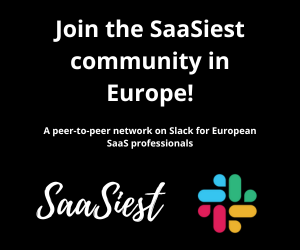If you’re interested in topics like this, you should join the SaaSiest CIO Network. Read more here: https://executive.saasiest.com/networks/it
AI is rewriting the risk map for SaaS – and most teams are still looking in the rear-view mirror. In this roundup, security and IT leaders surface 30 overlooked threats you’ll want on your 2026 roadmap: from deepfake CEO calls and “shadow AI” inside everyday tools to weak MFA in non-prod, vendor-stack cascade failures, and multi-tenancy shortcuts under cost pressure.
They also spotlight the risks you won’t see in a pentest – regulatory convergence (AI Act, NIS2, DORA), supply-chain compliance drift, the emerging “AI tax,” and culture traps like rushing certs before maturity.
If you’re responsible for trust, uptime, or growth, use this as a forward-looking checklist to pressure-test your plans – before these quiet risks become costly incidents.


Alexander Hall
IT Manager
Mentimeter
AI-Generated Phishing: Most people still underestimate just how convincing generative AI can be. A fake FaceTime call from your CEO could soon be indistinguishable from the real thing. This type of attack scales effortlessly – and I think we’ll see bad actors heavily exploiting it in 2026. Time to rehearse those code words.
Intellectual Property Contamination: AI-assisted coding introduces subtle but serious copyright risks that I hear little talk about. What if an AI model reproduces GPL-licensed snippets inside your proprietary product? It’s a low-likelihood but high-impact scenario – easy to avoid with rewriting, but hard to detect or enforce in practice.
Last but not least, maybe the scariest risk of them all: Being too AI-hesitant and missing the opportunity to speed up development and processes, and thereby falling behind the competition.


Per Malviker
CISO
Teamtailor
Too much or too little security
Many SaaS companies still swing between doing far too much and doing far too little. I cannot stress this enough. The right security level starts with your customers. What do they need, what do they expect you to protect, and what creates trust for them? Calibrate controls to those needs and to business criticality. Security should support the customer experience and product velocity, not block them.
A sprint, not a marathon
A growing risk is trying to move too fast, chasing certifications and frameworks before the basics are in place. Many companies run for an ISO 27001 certificate before they can even walk. Security maturity takes time and structure. If you rush ahead without building solid habits, clear ownership, and working processes, you risk creating the illusion of control instead of real resilience. Security should evolve step by step, each improvement tested and strengthened before moving to the next.
AI browsers and AI-driven shadow IT
AI browsers and agents are prone to prompt injections and can act on repeated instructions. That creates a new kind of shadow IT where automated systems may have wide and often unseen access to company data and tools. The challenge is that these systems do not behave like traditional software. They can make decisions, share information, and act in ways that are not always visible or predictable. As AI becomes part of everyday work, companies risk losing control over how data moves, how it is used, and who or what is actually making decisions. This lack of visibility can quietly turn into one of the biggest security and compliance challenges ahead.


Ragnar Sigurdsson
CEO & CISO
AwareGO
Under-estimation of third-party human-risk cascades
SaaS companies depend on vendors, plug-ins, services and contractors. The human behavior of those third-parties, e.g., weak processes, naive users, social engineers exploiting vendor help-desk staff that can expose you. It’s often overlooked in human risk programs.
Normalization of risk due to tool proliferation
As SaaS platforms multiply, users may become desensitized to security prompts, alerts or unusual requests. This fatigue leads to habitual “click first, think later” decisions, increasing susceptibility to social engineering, approval abuse or risky behavior.
Shadow IT & unmanaged SaaS adoption
Employees and teams spin up productivity tools or integrations outside approved channels, bypassing oversight, access controls or audit trails. This unmanaged surface becomes a high-risk gateway for misuse, data leakage or credential compromise


Ronald Jabangwe, Ph.D
CISO & Head of IT
Inriver
Unapproved AI in Everyday Tools.
The quiet rollout of AI features across everyday SaaS platforms has created a new blind spot for security teams. Many tools now include generative AI by default, allowing employees to share or process sensitive data through unvetted third-party models. This wave of “shadow AI” expands the attack surface and blurs accountability for data protection and compliance.
When AI Writes Code: The Accountability Gap.
AI agents can potentially be used to write and deploy code with minimal human oversight. While this accelerates development, it also introduces new risks — from insecure logic and hidden backdoors to unintentional data exposure. The lack of traceability raises serious questions about intellectual property ownership and accountability.
Regulatory Convergence: Data Act, AI Act, NIS2, and DORA.
Europe’s expanding regulatory landscape is redefining accountability for SaaS providers. The Data Act, AI Act, NIS2, and DORA all demand verifiable security, transparency, and operational resilience. For CISOs, compliance means proving that data flows are protected, AI systems are explainable, and digital operations can withstand disruption. These frameworks push oversight beyond policy into action, demanding constant monitoring, clear audits, and good governance to ensure SaaS companies stay compliant and keep customer trust intact.
In 2026, AI won’t just be about its potential to support technology advancement — it will test leadership, governance, and security culture. Competitive advantage will come not from speed of adoption, but from trust, transparency, and resilience. CISOs will be essential guides on the path to secure, responsible AI, and business success.


Pontus Nylén
CISO
Paligo
I just finished reading the new Cloud Security Alliance (CSA) Top Threats Deep Dive 2025 report, and a few of the key takeaways about overlooked risks for SaaS companies really jumped out at me, which I think more SaaS companies should address.
We need to stop trusting weak MFA. It’s clear that basic MFA (like SMS/OTP) is getting bypassed by attackers using social engineering and SIM swaps to steal credentials and tokens. We need to push for stronger methods like passkeys or hardware security keys.
Attackers are targeting test and dev environments because security controls (like MFA and least privilege) are often much weaker there than in production. A non-prod account with high access can be a critical point of entry. So we need to better scrutinize non-production environments.
I think many SaaS companies are relying on tools like Google Authenticator or other third-party integrations (OAuth exploits!) which creates vulnerabilities that many companies aren’t routinely checking. If a third-party app changes a feature (like syncing MFA tokens to the cloud), it can instantly become a security problem.


Per Thorsélius
CIO
Aurora Innovation
Risk of the build trap – focusing on one more feature instead of valuable/feasible/viable products
Risk of disqualifying cloud-providers/solutions based on unclear privacy concerns.
Risk of doing nothing. 😀


Andy Dyrcz
Information Security and Compliance Officer
Dreamdata.io
Developer-Led Shadow AI Sprawl
It’s not just about AI in your product. It’s AI building your product. Developers are using Copilot, Cursor, ChatGPT, and other AI coding tools every day, potentially exposing proprietary code, customer data schemas, and architectural details to third-party LLMs. Most companies have policies for production AI but almost none have thought about development-time AI usage.
What to watch: Developer-facing AI tool policies, code reviews that look for AI-generated patterns, and DLP controls that catch people pasting architectural diagrams into ChatGPT.
Vendor Concentration Risk and Cascading Failures
Most B2B SaaS companies run on nearly identical infrastructure stacks: AWS or GCP or Azure, plus Auth0 or Okta, plus Stripe, Datadog, Segment, and Slack. When a tier-1 provider has a major incident, it creates cascade risk across the entire SaaS ecosystem. We’ve seen glimpses of this with the CrowdStrike and Okta breaches or AWS outages, but most companies still don’t have real response plans.
What to watch: Geographic diversification of critical dependencies, runbook testing for scenarios like “Okta is down for 48 hours,” and contract language that acknowledges your vendor stack is also your competitors’ stack.
Multi-Tenancy Isolation Degradation Under Economic Pressure
SaaS companies are shifting from “growth at all costs” to “path to profitability,” which means intense pressure to optimize infrastructure costs by packing more customers into shared resources. This increases the risk of tenant isolation failures. In B2B SaaS, a single cross-tenant data leak can end your company.
What to watch: Architecture reviews that explicitly balance cost optimization against isolation trade-offs, tenant isolation testing under resource contention, and clear customer contract language around dedicated versus shared infrastructure.


Anna Kärrstrand
IT Manager
Voi
AI tax is the new SSO tax
While in the past a key driver for upgrades to Enterprise was the so called SSO tax we are now moving towards AI tax – where you cannot use AI integrations (or AI functionality at all!) unless you are on the correct tier. Be wary of investments that promise for example enterprise search – the integrations they depend on may be obsolete even before 2026.
Advanced phishing
Convincing others you are someone you are not is easier, and more convincing than ever. Faking the writing style, sound of their voice or even emulate video makes a lot of the verification methods used to authenticate users obsolete. Moving toward zero-trust is part of the solution, but being even more vigilant is key.
Your customers and your supply chain
Regulations and standards focus increasingly on supply chain security – who are your customers? Are you compliant and up to date with their new requirements? Are your suppliers? Long gone are the days of “we have iso-27001/SOC2, we’re fine”. If you don’t keep up you will lose key enterprise customers to competitors who prioritize this.


John Bojang
Head of IT
Funnel
Shadow AI adoption. Employees integrating unvetted AI tools pose new security and compliance risks.
Data exfiltration and privacy exposure. AI systems can unintentionally leak or replicate sensitive data if not properly configured.
Overreliance on automation. As teams lean on AI for decision-making and software development, human oversight and context can erode, introducing operational risks.


Magnus Ahlberg
CIO
Voyado
AI Inside
With vibecoding becoming increasingly common and AI browsers on the rise, we’re entering uncharted risk territory. Companies have spent years refining product management processes, discovery frameworks, secure SDLCs, static code analysis, and vulnerability management. Suddenly, they’re seeing new code produced by employees who’ve never touched source code or participated in a discovery process. The hard-won lessons of the past 20 years of software development now need to be relearned — by an entirely new group of people, at record speed.
Add AI browsers to the mix, and we’re not just talking about productivity gains — but new attack vectors and data leakage channels. As AI agents gain access to company SaaS platforms without the usual third-party protections, web scraping becomes the new API. When an agent acts as the user’s persona, a single prompt injection in one tab can have wide-ranging consequences across systems.
AI Outside
AI brings a new level of automation — and as with any powerful tool, it cuts both ways. Attackers are already combining autonomous agents with generative AI for voice, video, content, and code. The result: phishing that’s hyper-personalized, sophisticated, and credible — spreading across new channels like video calls and voice chats, even spawning AI-built honeypot sites to lure victims deeper. All of it, automated at scale.
What used to take a team of scammers a week can now be executed, with higher quality, by a single person with a well-prompted model in less than a day.
AI Nowhere
As with any new technology, knowing what to bet on is hard. The past few years have been littered with overhyped tech fads like crypto, Web3, and the metaverse, that left early adopters with expensive vaporware. But sitting out isn’t safer; it just guarantees you won’t win.
The real challenge is where and how to play. We tech leaders need to stick to a risk-based foundation: mitigate the critical risks, accept the minor ones, and experiment quickly. Move fast — but with guardrails. Fail early, while the stakes are low, learn fast, and scale what works.




